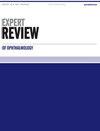Corneal transplantation in children - when and how?
IF 0.9
Q4 OPHTHALMOLOGY
引用次数: 1
Abstract
ABSTRACT Introduction Advanced surgical techniques, better post-operative protocols, imaging, and better understanding of genetic basis have enhanced outcomes of pediatric keratoplasty. However, results in infants and younger children remain a challenge. Transplants in the pediatric age group are challenging because of the complexity of the indications, the procedure itself, and the problems with respect to follow-up and post-operative care in younger recipients. Areas covered This review presents an overview of challenges faced in the management of pediatric corneal grafts, and problems encountered in long-term survival. We discuss the changing trends in these outcomes of PKP with a current review of the recent literature from PubMed. We also share the results of pediatric keratoplasty done at our center in the last three years and have an in-depth discussion about the management of comorbidities like cataracts and glaucoma Expert opinion Despite several advances in microsurgical techniques for corneal transplantation, pediatric keratoplasty remains challenging due to a variety of factors such as young age, repeated need for anesthesia, immature ocular tissues, and accelerated healing. The advent of component surgeries like DALK, DSEK, and DMEK has improved outcomes and simplified management options. Even after specialized surgeries, long-term follow-ups and management of comorbidities become essential.儿童角膜移植-何时以及如何进行?
摘要简介先进的手术技术、更好的术后方案、影像学和对遗传基础的更好理解提高了儿童角膜移植术的疗效。然而,婴儿和幼儿的结果仍然是一个挑战。由于适应症的复杂性、手术本身以及年轻接受者的随访和术后护理问题,儿科年龄组的移植具有挑战性。涵盖的领域本综述概述了儿童角膜移植物管理中面临的挑战,以及在长期生存中遇到的问题。我们通过PubMed最近的文献综述来讨论PKP这些结果的变化趋势。我们还分享了过去三年在我们中心进行的儿童角膜移植术的结果,并就白内障和青光眼等合并症的治疗进行了深入讨论。专家意见尽管角膜移植的显微外科技术取得了一些进展,但由于年龄小、,反复需要麻醉、不成熟的眼组织和加速愈合。DALK、DSEK和DMEK等组件手术的出现改善了结果,简化了管理选项。即使在经过专门的手术后,对合并症的长期随访和管理也变得至关重要。
本文章由计算机程序翻译,如有差异,请以英文原文为准。
求助全文
约1分钟内获得全文
求助全文
来源期刊

Expert Review of Ophthalmology
Health Professions-Optometry
CiteScore
1.40
自引率
0.00%
发文量
39
期刊介绍:
The worldwide problem of visual impairment is set to increase, as we are seeing increased longevity in developed countries. This will produce a crisis in vision care unless concerted action is taken. The substantial value that ophthalmic interventions confer to patients with eye diseases has led to intense research efforts in this area in recent years, with corresponding improvements in treatment, ophthalmic instrumentation and surgical techniques. As a result, the future for ophthalmology holds great promise as further exciting and innovative developments unfold.
 求助内容:
求助内容: 应助结果提醒方式:
应助结果提醒方式:


